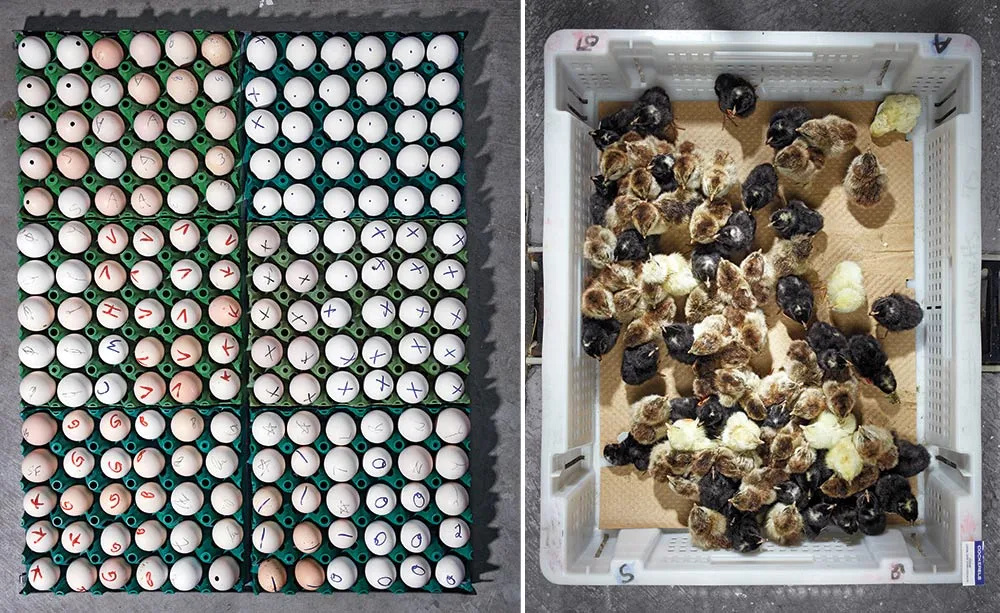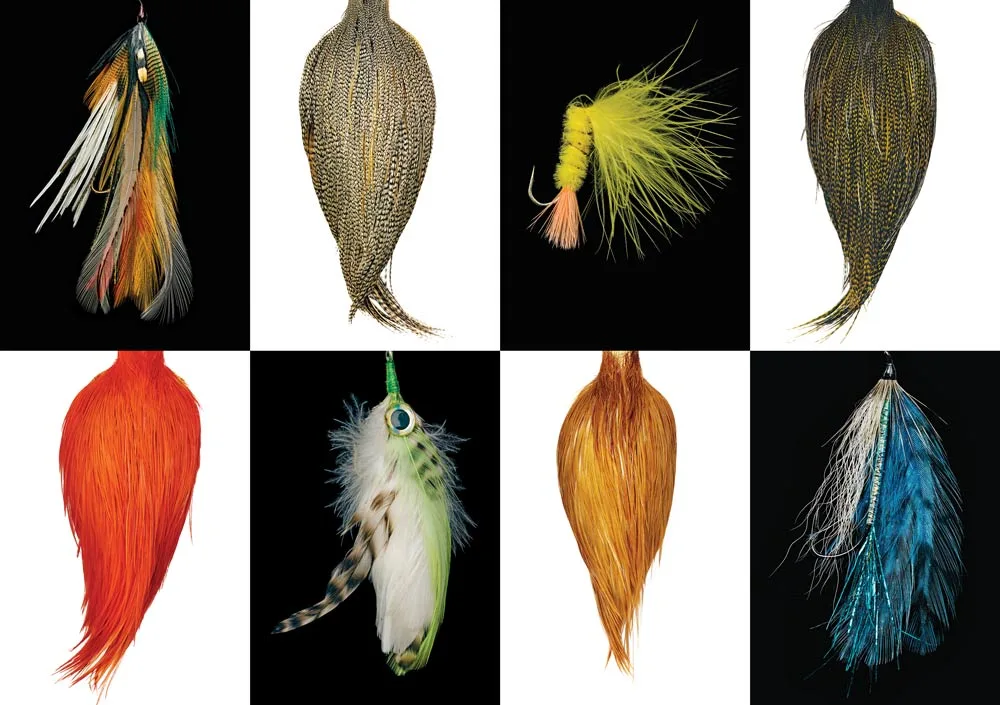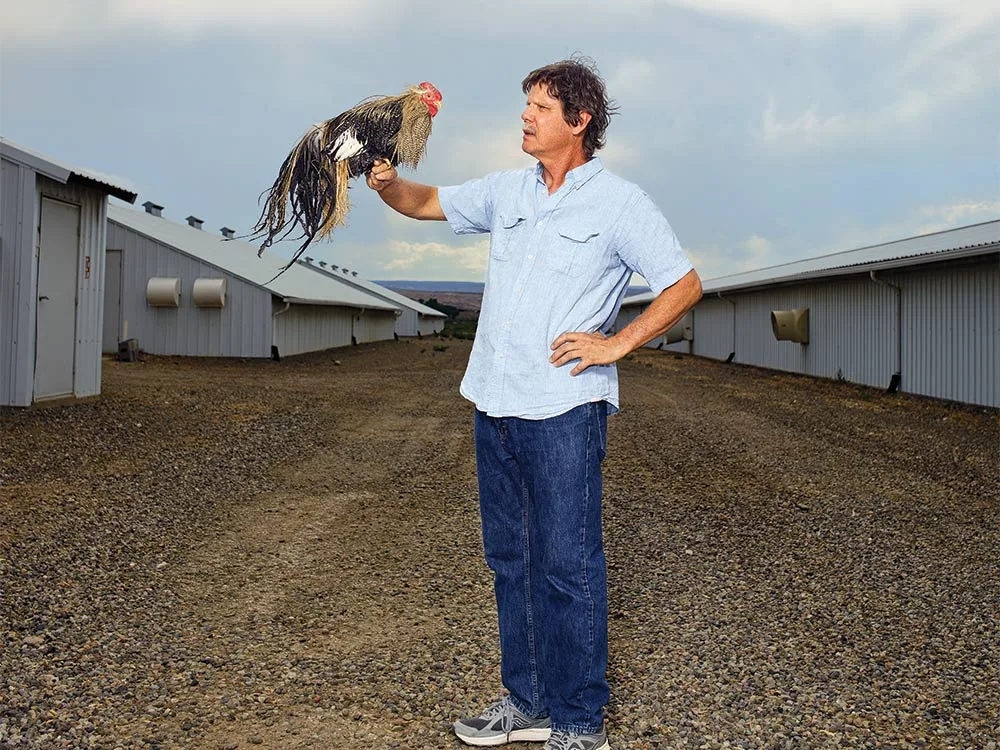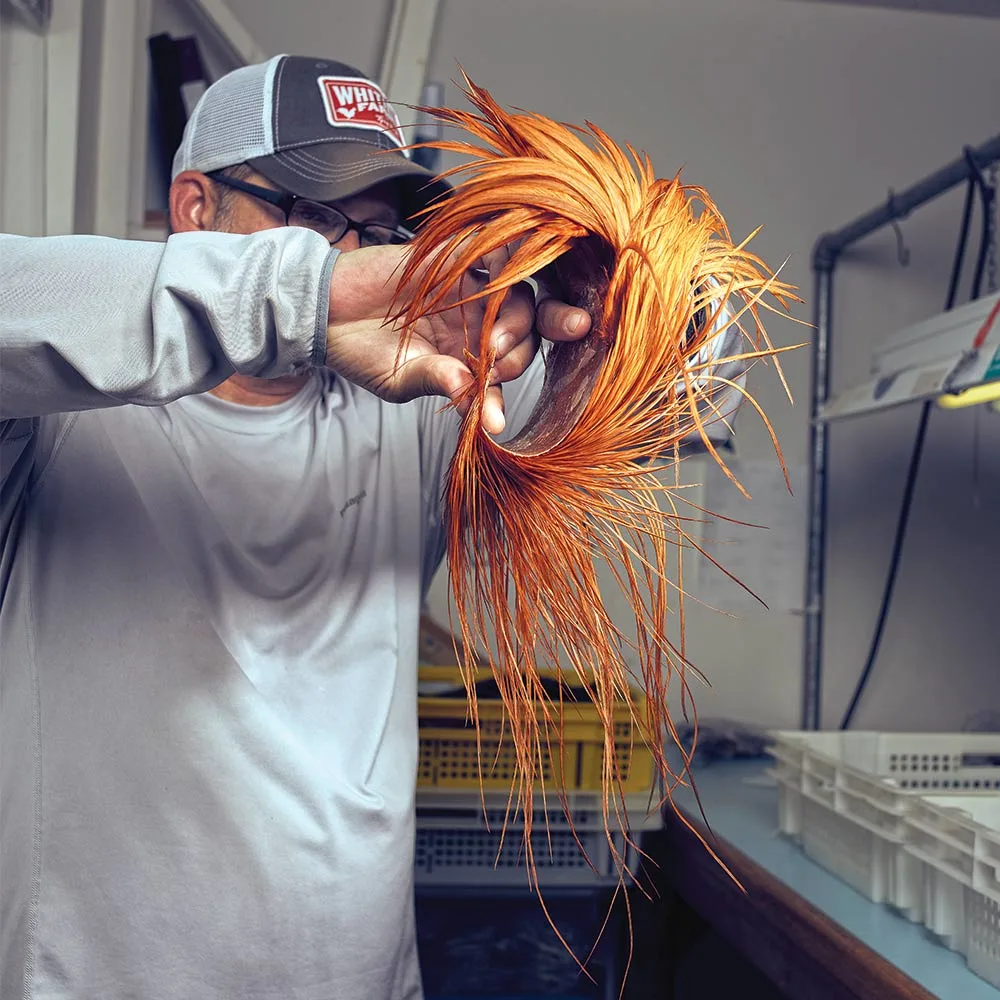_We may earn revenue from the products available on this page and participate in affiliate programs. Learn more ›
_
Tom Whiting noticed a pattern. It was the early 1990s, and fly-tiers from around the world were asking Whiting, a poultry geneticist, for a very specific feather. It had to be long, wide, fat-barbed, and without webbing or a frayed end—something more akin to a squirrel tail than a typical bird feather. The earliest British books on fishing mention such a feather, reportedly plucked from the neck of the Spey cock, an almost mythical rooster bred on the banks of Scotland’s River Spey and deeply connected to flyfishing’s 19th-century start. This chicken supposedly grew feathers that produced seamless, natural movements underwater and made for a fly no salmon could resist. For years, Whiting was fixated on finding this feather—writing letters to breeders and poring through books—yet he kept coming up blank. “Nothing convinced me that a distinct breed ever existed,” he says. “I found one idealized breed painting, and it looked like a Coq de Leon to me,” referring to a breed of Spanish chicken. But he just couldn’t leave it alone—so he took the matter into his own hands. “Even if this rooster doesn’t exist,” he decided, “I can build it.” Chickens, Whiting likes to say, are “genetically plastic.” Through selective breeding, a 4-pound barnyard hen, for example, can produce 8-pound great-great-grand-hens with wildly long feathers in an array of colors and textures. The normal taper of a feather—that elegant arc of, say, Shakespeare’s quill—can be altered to a pencil-like thinness or to as wide as an ax blade.
As for the Spey feather, Whiting knew that heron feathers had long been considered a substitute for Spey cock, and they reminded him of an ancient Chinese breed of chicken—the silkie. “Normally, feathers marry together at the barbs like a zipper,” Whiting says. “Silkies have a mutation where that’s lacking.” In other words, their feathers look and feel like fur. With a foundation stock of 50 silkies, Whiting bred in a laundry list of other chicken breeds—the exact formula he wouldn’t share with his own mother—and five years into the process, he had a pelt his tying experts were excited about.
Sales for what he called Spey Hackle were slow; they never caught on for steelhead, as he’d hoped. Then, in 2004, almost overnight, the sales spiked. Hundreds of pelts at a time were being ordered from Scandinavia. Later that year, at a trade show in Denver, a tall Danish guy named Claus Eriksen walked over to Whiting and slammed a fishing magazine down on his table. “You owe me,” Eriksen said.

Good Eggs: Whiting Farms hatches 1,400 to 1,600 chicks every week, and the incubators hold about 112,000 eggs. All told, there are about 100,000 chickens on the property on any given week. Ian Allen
In the magazine was a recipe for the Pattegrisen, or “Piglet”—a shrimp pattern that had taken the Baltic region by storm. Eriksen had designed the sea trout fly, which called for Whiting’s Spey Hackle, and in doing so, he revolutionized sea trout fishing. “Big cock hackles were too stiff, marabou was too floppy and full,” Eriksen told me. “If you look at a Spey Pattegrisen from below, the angle of the sea trout, you can see the similarity to a natural shrimp. The Spey fibers pulsate while it drifts in the water. Sea trout will strike this fly even on a hot summer day. It changed the way we fish.”
To this day, Whiting doesn’t take much credit for the Spey Piglet; to be fair, he didn’t create the actual fly. But he did make it a reality. Because without his feather—a feather he built through 10 years of genetic manipulation, working from nothing more than legends of a bird that most likely never existed—the pattern would not have been possible.
Bird Man
Tom Whiting knows a thing or two about feathers. He raised backyard chickens as a kid growing up outside of Denver and worked part-time at a gamebird farm during high school, which he graduated a year early. He attended Evergreen State College in Olympia, Wash., where he was miserable. One day, his older brother asked him what made him happy. “I can’t stop thinking about quail,” Whiting told him. So, he transferred to Colorado State University to study avian science and stayed in school through a doctorate in poultry science with an emphasis in genetics at the University of Arkansas. After wrapping up his dissertation, Whiting decided to get into the chicken business. A former professor of his from CSU owned Colorado Quality Hackles, and Whiting, though not a fisherman himself, liked the idea of raising birds for their feathers to be used for fly-tying. Whiting launched his own feather company in 1989, then stocked some secondhand incubators with eggs from Oregon.
Since humans started catching fish on hooks, feathers have been part of the formula, but the practice of raising chickens specifically for hackle didn’t take off in the U.S. until the 1920s. Breeders like Andy Miner, Harry Darbee, and Henry Hoffman pioneered genetic feather lines—that is, hackles from birds specifically bred to produce the best feathers for tying flies. After starting his business, Whiting purchased Hoffman’s entire genetic stock, and later acquired lines from Darbee and Miner.

Hackle to Hook: From wild patterns and colors to their freakish shapes and lengths, Whiting’s feathers are unlike anything you’d see on a farm chicken. But they do tie stunning fly patterns. Ian Allen
Today, Whiting is the No. 1 provider of feathers for fly patterns worldwide. Nearly every tackle shop in the U.S. stocks Whiting pelts; they’re shipped to 40 countries; and three out of four commercial fly-tying operations uses Whiting feathers. By one estimate, Whiting controls 80 percent of the feathers in the world tying market. Odds are, if you’ve cast a fly to a fish in the last 20 years, the feathers in that fly were hatched out of Whiting Farms in Delta, Colo.
Last summer, I traveled to Delta for a peek inside Whiting’s feather lab. When I hopped into his beat-up 4Runner he apologized for the lack of air-conditioning. He oversees every facet of his multimillion-dollar operation—from incubating eggs to packaging boxes—and doesn’t have time to service his vehicle. He’s wearing a T-shirt, khaki shorts, and black socks scrunched down into worn Asics. He is lean and hunched in the shoulders, walks fast, and is prone to rambling tangents on science and business. (A question about chicken feed leads to an answer on macronutrients and the economics of commodity corn.) Thirty years of claw rakes and beak tears have scarred his arms.
“People always ask how many birds we have here,” he tells me. “We hatch birds every Friday and process birds twice a week. We have space for 60,000 roosters. On the hoof, we’re probably somewhere around 100,000 birds at any one time.” The industrial incubators take up a room the size of a tennis court and can hold 112,000 eggs. His two ranches are separated by 7 miles of arid Colorado desert country, with duplicate bird lines kept at both locations should a biohazard strike. Every precaution is taken for the health and safety of the chicks—chicks that, in 40 weeks, could fetch anywhere from $35 to $100 apiece from fly-tiers.
Inside the Rooster Lab
We arrive at what Whiting calls Headquarters Ranch—home to the main office, processing plant, shipping department, four brooder barns, six rooster barns, and a hen barn. We’re not 2 feet into the office when he waves two chicken pelts in my face. They’re grizzlies—a black-and-white striped pattern that’s his top seller. One of the pelts is from the original Hoffman line, the other from Whiting’s genetically engineered update. The longest stretch of feathers on the Hoffman is maybe 6 inches. On Whiting’s pelt, the longest extends nearly 18 inches. This remarkable growth difference, coupled with a uniformity of feather size, is Whiting’s biggest innovation.

Odd Bird: Whiting is now 30 generations into his birds. “They’re a totally different animal,” he says. Ian Allen
Tom Rosenbauer, marketing manager for Orvis and an experienced fly-tier, says that in the 1970s, most feathers came off food chickens from India. “If we had seen a Whiting cape in those days,” he says, “we’d have thought we were seeing something from outer space. Back then, you’d need a minimum of two hackles to tie any dry fly, and a Royal Wulff would take three or four. Now we can get six to 10 Wulffs from one hackle from Whiting.”
Natural feathers are narrow at the tip, wider through the body, and taper again at the base. For them to grow endlessly or develop a uniform size, an eager breeder needs to step in. To achieve the freakishly narrow saddle feathers that grow along the back of Whiting’s birds, the genetics had to be short-circuited through intensive breeding. The follicles, so to speak, are programmed to grow only narrow feathers. At a glance, they resemble a snakeskin more than anything you’ll find on a farmyard chicken. And to support these long feathers, Whiting’s birds are bred with longer legs so they won’t trample that prized plumage.
Feather traits that create better fly patterns range from the obvious to the subtle. For example: The longer the feather, the more dry flies it will tie. Also, the higher the barb density along the quill, the stiffer the barb, the tighter the collar, and the better that fly will stand on the water’s surface. The barbs should be of uniform length on a quill that’s flexible and has a natural taper to mimic an insect, but that’s also strong enough to stand up to repeated fish strikes. Smoothness of the barbs is important, too, as it makes for fluid motion across the water’s surface. Creating all those qualities in a single feather, Whiting tells me, is the result of decades of selective chicken breeding.
“The unit of use is the individual feather,” he says. “The whole breeding program is focused on the feather. From all the manpower, the infrastructure, our location, the feed, the cages, the lighting, the temperature—it’s all geared to the individual feather. If any part of the operation slips, the bird will internalize it and won’t reach its full genetic potential.” Back in his office, that tedious, meticulous precision isn’t so apparent. Notepads, folders, newspaper clippings, and scribbled messages lay scattered. Piles on the desk and filing cabinets have spilled to the floor, and packets of hackle are everywhere. The office looks as though it has been tossed in a police raid. When I point this out, Whiting shrugs it off. “Hey,” he says, “my breeding records are immaculate.”
We walk outside, and Whiting leads me to another building where he removes a padlock and swings open a steel door. Inside this barn, his life’s work—8,800 roosters—is on fine display.
A rooster’s crow measures about the same decibels as a dog’s bark, and with thousands crowing at the same time, the atmosphere is utter chaos. We pass row after row of roosters in cages. The conditions are dense, but the birds have room to move and stretch out. They are not friendly, flaring up their neck hackles and striking through the wire cages.
The idea of birds in cages bothers many people, but Whiting swears that if he were to die and come back a chicken, he hopes it’s here at Whiting Farms. The birds are treated well and live comfortably, he says. That’s partly because he’s a good guy, who loves animals, but it’s also a matter of science. As Whiting puts it: “All the preceding metabolic needs of the bird must be more than met in order for ample surplus nutrients to be available for feather growth.” In other words: Feathers are the last thing a bird’s body spends energy on. Lousy air quality, loud disturbances, poor vaccinations, nonuniform lighting, temperature swings, rodents, rough handle, unsanitary cages—any of those factors can take away from the feathers. “Basically, anything that isn’t optimum for roosters, or in any way stresses them, chips away at the feather quality,” he says.
As for that feather quality, the birds on display are almost otherworldly: Polish chickens with white top hats that will someday be sea trout flies fished in the Baltic Sea; giant Brahman chickens with feathers on their feet and downy saddles designed for nymph collars; blue Andalusians whose ancestors were first selected 30 generations ago near Roscoe, N.Y., for their telling shade of gray, the perfect match for a Northeast mayfly wing; Coqs de Leon imported from Spain, for which Whiting points out minute speckling in each individual feather, a trait prized by tiers since the 1600s. The cages run on and on like this, full of chickens boasting brilliant feathers that might, one day, entice a strike and spark a fish story.
No End in Sight
On my last morning, Whiting comes to work with a stack of empty Purina cat-food boxes. “It’s my job to stoke the fire in the hot room on Sundays,” he says. After a check on a barn cleanup, he and I head over to a breeder barn. His very best birds aren’t caped and sold, but matched and mated to make more chicks for more feathers for more flies.

Quality Control: A single Whiting pelt can be used to tie several hundred flies. Ian Allen
Whiting still hand-inspects every grown bird for the breeder pens or processing. In his career, he figures, he’s personally inspected 2.8 million chickens. “You develop in your mind’s eye what a good pelt looks like,” he says. “People who want to get into this, I tell them it takes five years to really learn hackle.” Today, he can speed-spot the truly outstanding birds. The top 2 or 3 percent of his flock is flagged, and Whiting returns to further scrutinize them. Most of the birds don’t pass a closer inspection, but if they do, Whiting takes out the calipers, starts noting measurements, and fills out a two-page report on body measurements like shank length, as well as the bird’s disposition. The whole process takes about 45 minutes per bird, and the few that pass have 12 feathers plucked and hook-tested by his in-house tying expert, Phil Trimm. Those that pass that test—a fraction of the top 1 percent—are moved to the breeder shed, where they’re caged with a harem of 10 to 14 hens.
When making the first cut of breeder candidates, Whiting will handle 800 roosters in a day. “I play games with myself to keep my concentration going,” he says. “I try to identify the line of bird by feel, just to keep my head keyed up. I go through miles of cages, up and down those rows with a guy handing me birds under a bright light. Sometimes I get it right—not always, but sometimes. I can tell a Hoffman grizzly blindfolded, because I know the feel of those feathers—the density of the pigment in the black makes a softer section. The white is a harder hackle.”
Inside the breeder barn, every pen has a cardboard sign and code indicating the genetic line—AX3, F19, CR17. Whiting knows them all by heart. Most geneticists work with spreadsheets and software to track lines and traits, but Whiting holds most of it in his head, filling out the edges with scribbles on the legal pads that overflow his office.
The sound of all these chickens makes it hard to talk, so we step outside. Whiting brings a bantam grizzly rooster with him and holds the bird up to the sky. The bird shifts in his grip, then settles into the hold. Whiting has been approached several times about selling everything—his company, buildings, and birds—but he won’t entertain the discussion. He talks at great length about the “vast genetic repository” that happens to be “entrusted” to him, and that ultimately benefits outdoorsmen—whether they’re aware of him or not. It’s amazing to consider, really. A guy who took a childhood interest in birds, then created the most sought-after feathers used for flyfishing, and who still works all day, and most nights and weekends, obsessing over every detail. All from a guy who doesn’t even fish.
“I was a nervous kid, had trouble sitting still,” he tells me. “I’m sure I would have been diagnosed with one of the maladies they throw around today. I needed an outlet, and I have one—with these birds. It’s long term. It’s difficult. It suits me, temperamentally. I’ve found peace walking the barns, looking at roosters six hours a day.”
He’s looking at a bird right now. The bantam grizzly has relaxed and is soaking in the hot desert sun. The way he stares at the bird is striking. In his eyes you can see love for the animal—but there’s something else, too. A sense of fascination, perhaps, or a sense of awe in accomplishment, of satisfaction from seeing all of your hard work come together.
“What’s the perfect feather?” I ask him.
“I hope I never find it,” Whiting says. “I hope it’s always out of reach.”






